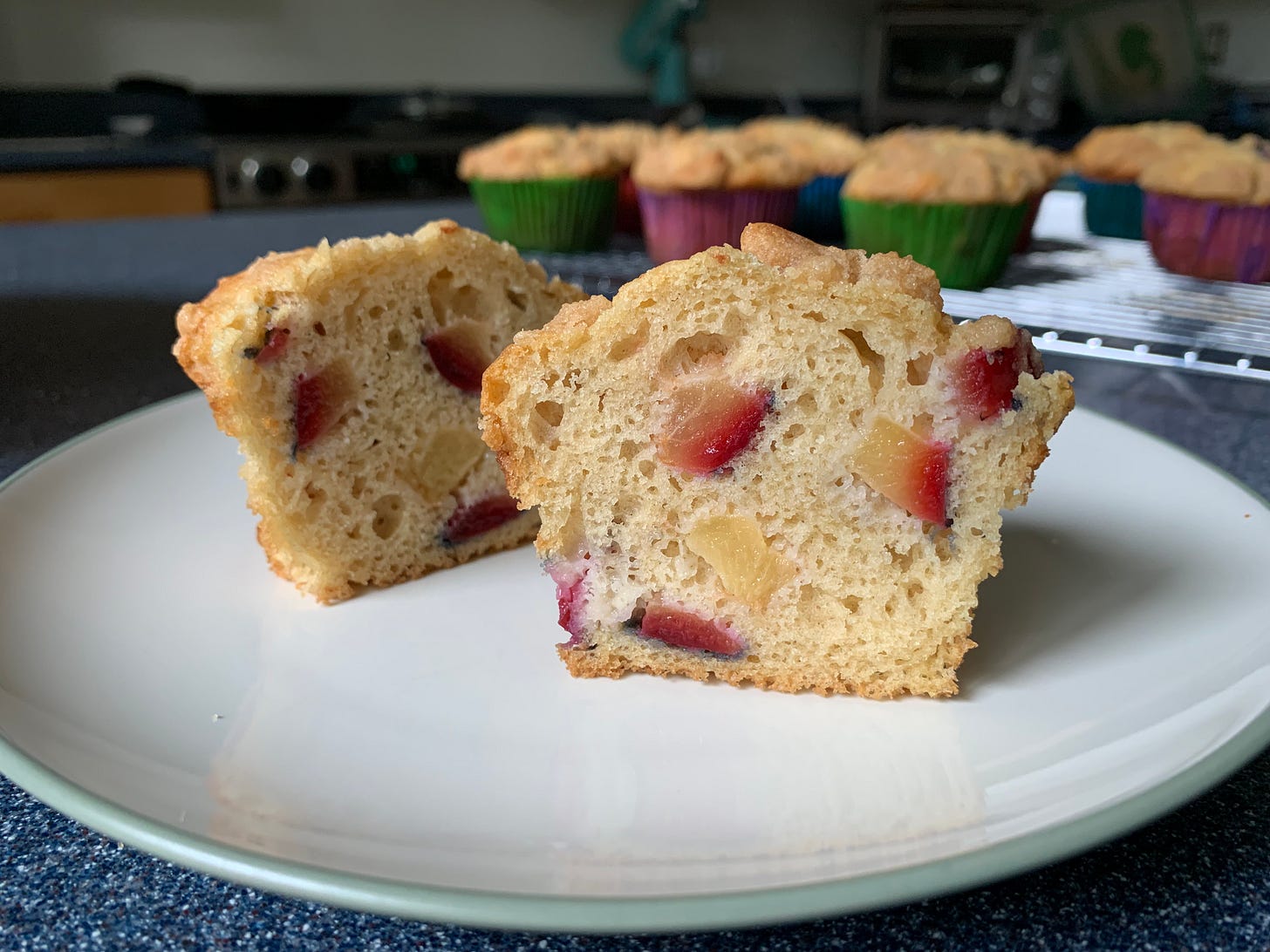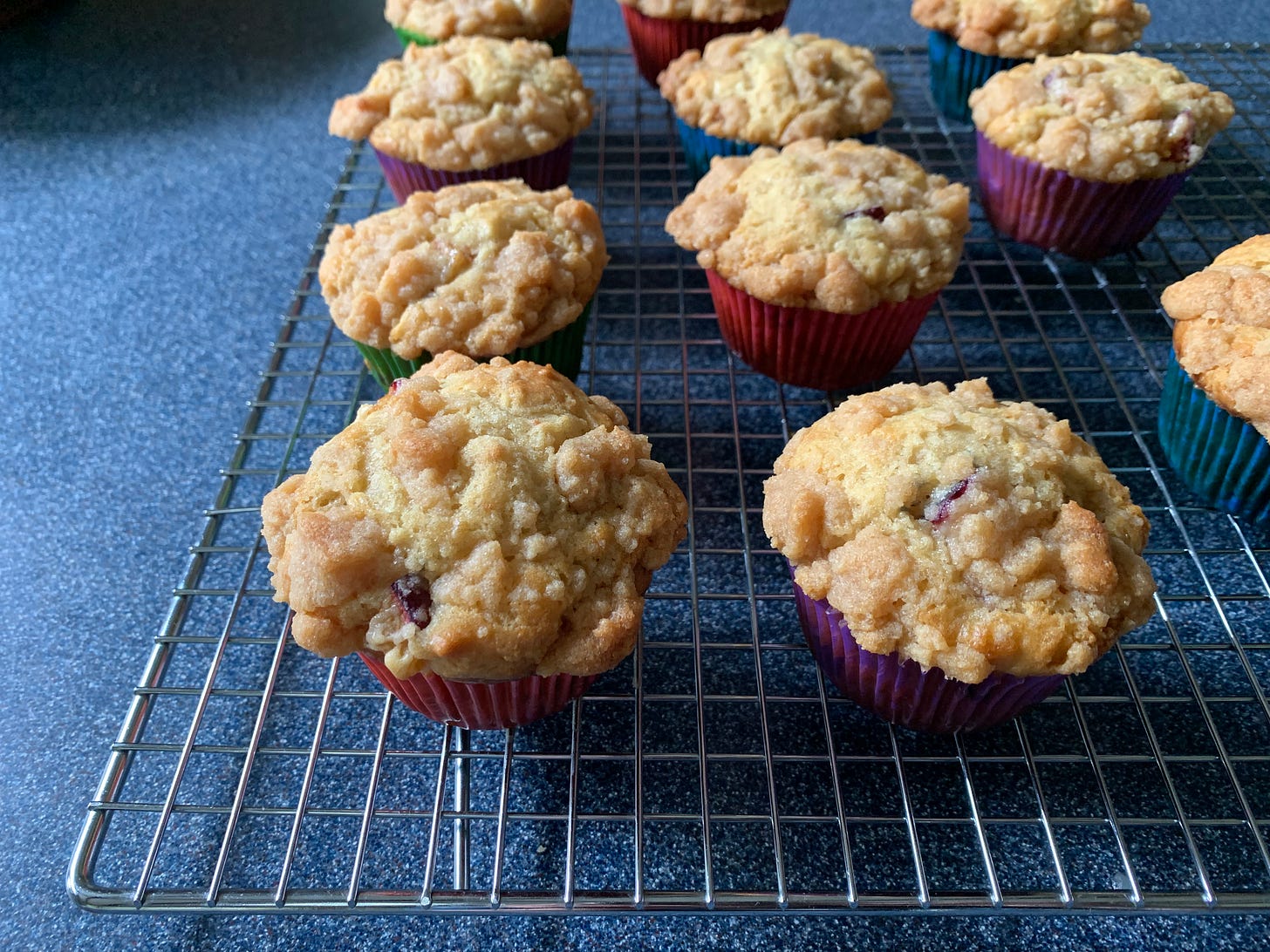Confession: I always thought that muffins were breakfast cake with fruit inside and no frosting on top. They are decidedly not.
The recipe
Yield: 12 muffins
Time: 1 ½ hours
Ingredients
Crumb topping:
½ stick (4 tbsp or 56 g) salted butter, melted
⅓ c (50 g) flour
3 tbsp (35 g) sugar
3 tbsp (40 g) light brown sugar
3 tbsp (35 g) malt powder
Muffins:
1 ¼ c (190 g) flour
⅓ c (70 g) sugar
1 tsp baking powder
1 tsp baking soda
½ tsp salt
3 plums, diced in ½ -inch pieces
½ c (130 g) plain Greek yogurt
2 eggs
1 tbsp (12 g) vanilla extract
3 tbsp (42 g) salted butter, melted
Instructions
Crumbs:
1. Preheat the oven to 350°F and line a muffin pan with liners.
2. Melt the butter in the microwave. Set aside.
3. Combine the remaining crumb topping ingredients in a bowl and mix with a fork until they’re even and no longer lumpy.
4. Pour the butter into the dry ingredients and mix with a fork until the crumbs are evenly moistened and there are no dry bits remaining. Set aside.
Muffins:
1. Combine the dry ingredients (flour, sugar, baking powder, baking soda, and salt) in a bowl and stir to combine.
2. Add the plums to the dry ingredients and toss them until they’re evenly coated with the flour mixture.
3. In a separate bowl, add the wet ingredients, except for the butter. Whisk well to combine until the eggs are broken up and the mixture is even and well-mixed.
4. Pour the wet ingredients into the dry ingredients, and stir until mostly combined (there should be some wet and some dry spots in the mixture).
5. Pour the melted butter into the muffin batter and stir again, just until everything is combined and there are no dry spots remaining.
6. Scoop the muffin batter into the twelve muffin cups and smooth out the tops if needed.
7. Using your fingers, sprinkle the crumbs on top of the muffins and press them gently into the batter to adhere. It will be a lot of crumbs!
8. Bake the muffins for 22–24 minutes, or until a toothpick inserted into the center of a muffin comes out with a few moist but cooked crumbs clinging to it.
9. Let the muffins cool in the pan for 10 minutes, then transfer them to a wire rack to finish cooling completely.
Notes and tips
It’s important to add salted butter to the crumbs. Unsalted butter will leave them too sweet, and regular salt won’t dissolve in the crumbs when they bake.
You don’t need the juiciest, freshest plums for this recipe. In fact, plums that are less juicy will result in a better-textured muffin overall because they won’t leak their liquid into the batter.
Coating the plums with flour before mixing the wet ingredients helps them stay evenly distributed in the batter instead of just sinking to the bottom.
The secret to the fluffiest muffins is to mix them gently and just until the batter is combined. Over-mixing (like I did with my first batch) could make them tough.
This batter will feel very sticky, and almost more like bread dough than muffin batter, so don’t think you’ve done it wrong! Muffins are supposed to be denser than cake.
If you don’t eat all of the muffins the day you make them, here’s a way to make the leftovers even better than the fresh ones! Store them in an airtight container in the fridge. The next morning, slice them in half and butter the sliced halves. Heat a pan on low, then add the muffins to it, buttered side down. Cook the muffins until they’re browned and crispy on the buttered sides. (This trick comes from my dad, who would always do this if we had leftover muffins.)
The story
You’re probably saying to yourself, Megan, are you sure muffins aren’t cake? They have a sweet topping made of sugar and butter, which sounds a lot like frosting. And the texture seems like cake. The ingredients in the batter are pretty much the same, and muffins don’t have any less sugar than a cake. Yes, dear reader, those things are true, but I am still sure that muffins aren’t cake, and here is why.
When I started developing this recipe, the cake instincts kicked in. If I know one thing, it’s how to bake a good cake. So for the first batch, I did what I do for all my cakes: used the mixer and beat the batter for a good two minutes before baking it up. But my muffins were dry and tough. Weird. My cakes had never done that before. I went back and researched the method for muffins. Turns out they need very little mixing (who knew!), so I decided to stir by hand for the next batch. The cake instincts, undeterred, whispered in my ear: if you want a moister muffin, add more milk. If you want a more tender muffin, use oil instead of butter. And I thought, You’re right, cake instincts. You’ve never been wrong before. I did what they said and the result was delicious little plum cakes, but the plums and crumbs had sunk all the way to the bottom and clumped up there, and the muffins fell apart when you tried to take the wrapper off and eat them. Cake is not a finger food (unless it’s a cupcake, but even then I prefer to go at it with a fork.)
So I did even more research, saw that most muffin recipes have less liquid and use butter instead of oil, so I made those changes and tried again. This time, the batter looked very thick when I scooped it into the pan, and my cake instincts shouted, They’ll be dense and dry! That batter doesn’t look right! I kept repeating “muffins aren’t cake” to them as I put the pan in the oven, albeit with a fair amount of trepidation. When I tasted a muffin and found that it was moist and delicious, I shocked the cake instincts silent, and they finally agreed with me: muffins aren’t cake, indeed.
Spread the snob
If you like this recipe, please recommend Confessions of a Cake Snob to someone you know! Follow me on Pinterest or Instagram for more ways to view and save the recipes. Please share this newsletter with a friend, comment on the website, or bake it and let me know how it went for you! Email me with comments, things you’d like to see, and suggestions at confessionsofacakesnob@substack.com.





These look so tasty....
It is so interesting that muffins are so different from cake. Now I’m wondering how each came to be